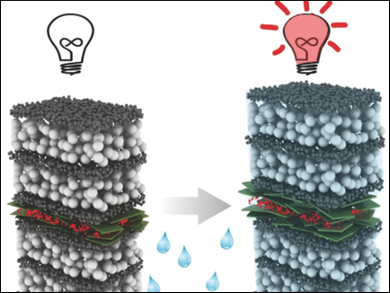Photonic crystals (PhCs) are optical materials with a periodic nanostructure. The reflectivity of light of a PhC originates from a periodic arrangement of materials with different refractive indices (RIs) that interacts with photons. Photonic resonators are PhCs with a defect structure, e.g., an intercalated layer, which forms an optical cavity that amplifies the light signal.
Bettina V. Lotsch, Max Planck Institute (MPI) for Solid State Research, Stuttgart, Germany, Hernán Míguez, Universidad de Sevilla, Spain, and colleagues have developed a sensor that shows a photoluminescence response to changes in ambient humidity. The sensor is made of stimuli-responsive photonic resonators with light-emitting nanospheres. The fluorescent nanospheres are embedded in antimony phosphate nanosheets, which are known to strongly swell in the presence of water. During swelling (pictured), the photonic environment changes, which influences the emission properties of the embedded dye molecules. This leads to a dynamic fluorescent response to changing humidity levels.
The team prepared two systems where the fluorescence could either be turned on or off once exposed to a relative humidity of 75%. These systems are the first examples of luminescent sensors based on photonic effects and are of particular interest for environmental monitoring in high-humidity conditions.
- Fluorescent Humidity Sensors Based on Photonic Resonators,
Katalin Szendrei, Alberto Jiménez-Solano, Gabriel Lozano, Bettina V. Lotsch, Hernán Míguez,
Adv. Optical Mater. 2017.
DOI: 10.1002/adom.201700663


